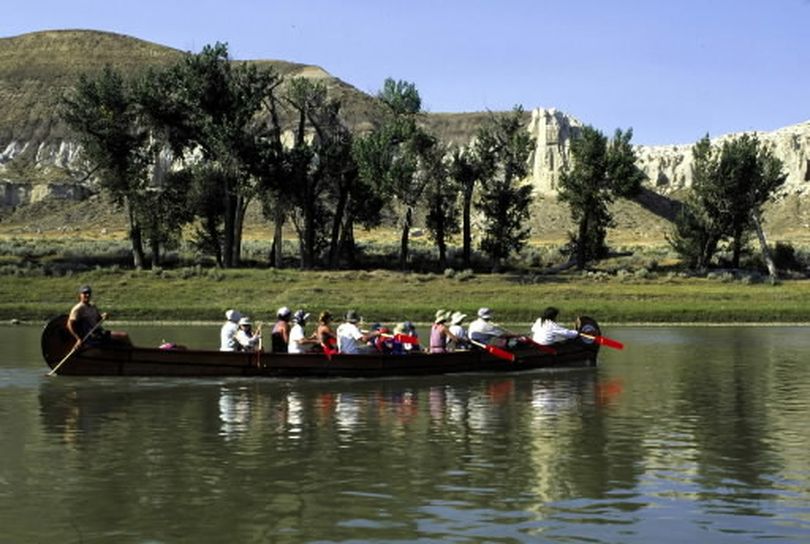BLM director tells ranchers: Still no plans for Mont. monument

PUBLIC LANDS -- Ranchers continue to cow the federal governement from expanding the Upper Missouri River Breaks National Monument, which eased under the national spotlight in the past two decades along with interest in the bicentennial of the Lewis and Clark Expedition.
The head of the federal Bureau of Land Management returned to Montana on Monday with a message similar to the one he delivered to ranchers a year ago: No new national monuments.
As part of a tour of rural communities across the West, BLM director Bob Abbey met with about 20 ranchers still upset over the creation of the Upper Missouri River Breaks National Monument by former President Bill Clinton more than a decade ago.
Ranchers noted that the monument had not substantially changed their operations, but noted that efforts of environmental groups to curtail grazing on monuments is a constant worry to them.
Read on for details from the Associated Press report.
Echoing comments he made during a visit to Malta last September, Abbey said there were no pending plans to create a second monument in the area. That prospect was first raised in Obama administration documents in 2010 that continue to provoke suspicions among ranchers.
“We’re not here to screw you over. We’re not here to make your life miserable,” Abbey told the group of ranchers in the agricultural community of Winifred. “My job is to try not to create issues that cause you grief. This is a partnership. If you ever hear of anything or have any concerns, pick up the phone and call me.”
Crediting the ranchers for helping to restore the monument’s natural landscape, Abbey indicated he had no intention of betraying their trust and intended to work with them to preserve BLM-managed land that many ranchers rely on for grazing leases.
Fergus County Commissioner Carl Seilstad said the BLM director’s visit was welcome because it offered a chance for open communication. But he added that the people of his county remained wary over the potential for a new monument given that the Upper Missouri River Breaks was established over local objections.
“I don’t think we’re ready to put our guard down,” he said.
Three months after Abbey’s 2010 trip to Malta, the Department of the Interior proposed a plan to allow millions of acres of undeveloped land in the West to be designated “wild lands.” The new designation would have allowed some federal land protections for areas while Congress considered making them permanent wilderness areas.
Details about the new land designation were not clear, such as how long land could be managed under those protections or whether those areas would be off-limits to motorized recreation or commercial development.
The next month, in January, Salazar backed away from the proposal after criticism that the “wild lands” designation was an attempt to close land to development without congressional approval.
Adding to the ranchers’ fears has been a conservation group, the American Prairie Foundation, buying up tens of thousands of acres in central and eastern Montana with the goal of a creating a reserve for bison and other wildlife. Abbey said the BLM has no intention of getting involved in bison management.
Yet another perceived threat to central Montana’s agricultural community emerged last week, when Gov. Brian Schweitzer said he would look to trade state land inside the existing monument for federal property elsewhere.
Livestock producers said having those state parcels interspersed within the monument gives them leverage in the ongoing debate over how much grazing should be allowed in the 375,000 acre monument. Without that leverage, they contend it would be easier for the BLM to justify ending or restricting those leases.
Abbey said the BLM would consider swapping state land within the monument for federal property elsewhere, but no offer has been made. He said BLM representatives in Montana have meetings with state officials planned for this fall to discuss possible land swaps in the Breaks and other issues.
Near the end of Monday’s discussion, Abbey asked if anyone had been forced to alter their ranching practices because of the monument’s creation, which included provisions that have allowed grazing permit holders to continue using the land.
Winifred rancher Matt Knox acknowledged that his day-to-day operations had changed little. But he added that pressure on the BLM from conservation groups to impose more sweeping restrictions on permit holders was a constant worry.
“There are some people arrayed against us — I’m not talking about the BLM — that basically want us out of there. They view a monument designation or a wild and scenic designation as a vehicle they can use to achieve that goal,” Knox said.
